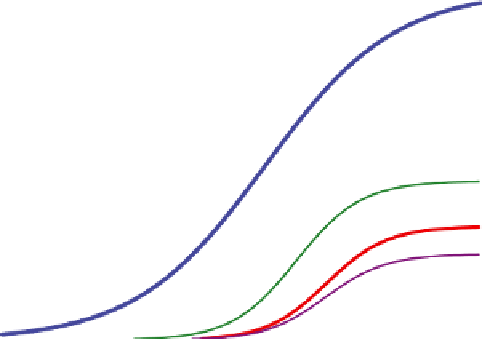Biomedical Engineering Reference
In-Depth Information
220
α4β3δ
200
α1β3γ2
α2β3γ2
180
α3β3γ2
160
α4β3γ2
140
α5β3γ2
120
α6β3γ2
100
80
60
40
20
0
0,1
1
10
100
1000
10,000
Gaboxadol (μM)
FIGURE 20.8
Dose response curves for gaboxadol at different GABA
A
receptor populations expressed in
Xenopus
oocytes. The therapeutic relevant concentration is 1-2 micromolar. (Data from Storustovu, S. and
Ebert, B.,
J.
Pharmacol. Exp. Ther
., 316, 1351, 2006.)
efi cacy and low potency to high potency and high efi cacy. For example at non-g-subunit containing
GABA
A
receptors, gaboxadol elicits a larger maximal response than GABA. a4d containing GABA
receptors are located extra-synaptically and are present at neurons projecting to areas contributing
to the modulation of sleep. One of these important areas is the ventrobasal region of the thalamus,
which seems to play a key role for the hypnotic activity of gaboxadol. In normal animals, gabox-
adol enhances the amount of SWS and, in particular, the SWA as recorded using EEG technology.
Furthermore, in mice lacking the d subunit, Gaboxadol dose not enhance SWA, illustrating the
contribution of this receptor population to the physiological effects of gaboxadol. Since the relative
in vitro proi le of gaboxadol is shared by other GABA
A
receptor agonists, including partial ago-
nists, a novel CNS penetrant GABA
A
receptor agonist most likely will share the hypnotic effects of
gaboxadol.
Gaboxadol was in clinical development for insomnia but was discontinued due to variable
effects on sleep induction in the i nal studies. However, since the clinical development program
only included primary insomniacs, little is known about the clinical consequences of enhanced
SWS and SWA. The hypnotic proi le of gaboxadol indicates that GABA
A
receptor agonists may
play a role in diseases where reduced SWS or enhanced and early onset of REM sleep is a core part
of the disease. These conditions include psychiatric diseases (e.g., depression, anxiety, and bipolar
disorder), neurological diseases (Alzheimer's disease and Parkinson's disease), stress and chronic
pain syndromes.
20.3.2.2 5-HT
2A
Antagonists
As speculated above, compounds with positive effects on SWS may have a particular value in a
number of diseases. Therefore other strategies for enhancing SWS have been attempted. A very
promising approach relates to the inhibition of a subpopulation of serotonergic receptors: 5-HT
2A
receptors. Compounds with antagonist properties at these receptors were initially developed in the
psychosis area, but at lower doses these drugs demonstrated a selective and short-term enhancement
of the SWS/SWA during the night. Examples of these compounds are ritanserin, ketanserin, and
eplivanserin (Figure 20.9). Interestingly, none of these compounds have yet demonstrated effects on



































































